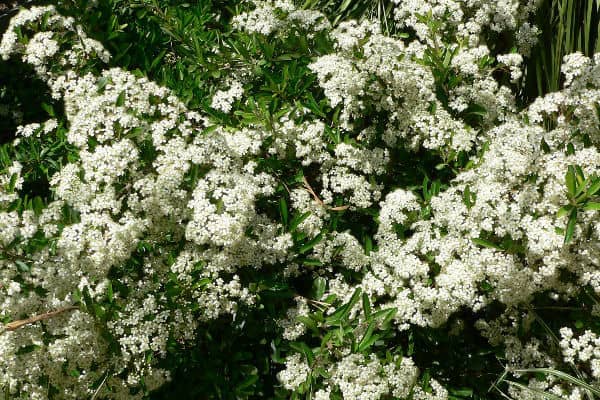Last updated on January 25th, 2022
Our site is reader supported, this means we may earn a small commission from Amazon and other affiliates when you buy through links on our site.
Pyracantha rogersiana (Asian Firethorn)
Originating from Western China, the Pyracantha rogersiana is a drought-resistant, evergreen and bushy shrub that is ideal for forming a hedge or as a border/wall shrub. The arching branches produce creamy-white flowers in spring followed by orange/red berries in autumn and these provide food for many species of wildlife and birds.
This evergreen shrub has oblong leaves that are around 4cm long and spiky branches, so it often makes a good deterrent hedge for protecting your property.
- Common name: Asian firethorn.
- Family: Rosaceae.
- Evergreen arching branches.
- Creamy-white flowers in spring, followed by red/orange berries in autumn.
- Height and spread over 10 years: 4 metres x 4 metres.
- Toxicity: Seeds will cause mild stomach upset if ingested.
- Drought resistant.
- Low maintenance shrub.
- Pyracantha ‘Flava’ has been awarded the RHS ‘Award of Garden Merit’.

Image Source wikipedia.org
Where to plant
Pyracantha is a versatile shrub that grows well in most positions and is tolerant to pollution. They will grow well in any PH level and soil type including chalk, loam, sand and clay in moist soil, but ensure it is well-drained. They will thrive in full sun or semi-shade, in sheltered or exposed sites. Ideal for forming hedges and screens it also grows well in coastal areas. It is a good shrub for planting in cottage gardens against a wall or trellis framework.
Pruning
Pyracantha is very easy to maintain and are a good low-maintenance shrub. Hedging should be pruned twice a year in summer and autumn with a good pair of secateurs to keep to a formal shape. Informal hedges can be pruned to remove any unwanted branches. Remove old berry trusses in spring and cut back any branches to a permanent framework in autumn as well as remove any diseased, damaged or unwanted growth.
Propagation
Pyracantha is very easy to propagate by taking semi-hardwood cuttings in summer or hardwood cuttings in autumn.
Pests to watch out for
Watch out for aphids, caterpillars, woolly aphids and brown scale. Check in the spring and use a garden sprayer to spray with a pesticide at the first signs of any pests.
Diseases to watch out for
Watch out for Pyracantha Scab which is a serious fungal disease. The dark black spots that appear on the leaves and branches in early summer are easy to spot and look out for the scabs on the berries in autumn. Remove all affected leaves and branches at the first signs and burn them (do not place them on the compost pile). It is also important to also remove any fallen leaves.
Fireblight is a systemic disease and is spread by pests, aphids and birds. It can be a problem with all Pyracantha cultivars and it causes the leaves and flowers to turn black and scorched. Remove all affected leaves, branches and flowers and burn them. Spray plants with antibiotics streptomycin or terramycin to help prevent new infections to plants.


